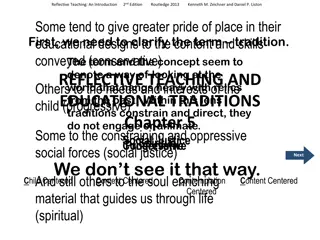Exploring Sikhism: Traditions and Beliefs | Year 5 RE Summer Curriculum
Delve into the teachings and practices of Sikhism in the Year 5 RE curriculum. Learn about the significance of the turban, key Sikh traditions, equality values, and unique aspects of Sikh beliefs. Discover inspiring stories and videos that illustrate the core principles of Sikhism, including respect, equality, and religious freedom.
Download Presentation

Please find below an Image/Link to download the presentation.
The content on the website is provided AS IS for your information and personal use only. It may not be sold, licensed, or shared on other websites without obtaining consent from the author. Download presentation by click this link. If you encounter any issues during the download, it is possible that the publisher has removed the file from their server.
E N D
Presentation Transcript
Year 5 RE Summer 1 - Week 3 4th 8thMay 2020 Please send work back to your teacher: 5WL: elangoo@kingsavenue.lambeth.sch.uk 5B: mbarlow@kingsavenue.lambeth.sch.uk
This half term we are going back to Sikhism What do you remember about Sikhism from before?
This half term we are going back to Sikhism What do you remember about Sikhism from before (Spring 1)? Holy book - Guru Granth Sahib. Kept covered to show respect. Guru Nanak was the first prophet. Story of Bhai Lalo - Guru Nanak visited a village. A rich man (Malik Bhago) wanted to show off, but Guru Nanak chose to stay with a poor man (Bhai Lalo). At Malik s feast, Guru Nanak squeezed one of the cakes and blood came out. Milk came out of Lalo s bread. This showed that the rich man had earnt his money by cheating the poor and being dishonest. Malik changed his ways and followed the Guru from then on.
Lesson 1 Monday 4thMay 2020 LO: To understand that there are different factors that affect our everyday choices
Why do Sikhs wear a turban? Watch this video on the significance of turbans in Sikhism: https://www.youtube.com/watch?v=36d6aXFny7M
Recap of Sikhism Watch this video which describes the key factors of Sikhism: https://www.youtube.com/watch?v=qXhV3dMxSzE Where is the most important Sikh temple? Is equality important to Sikhs? Give an example of how they show equality.
Sikh traditions Watch this video on Sikh traditions https://www.bbc.co.uk/bitesize/clips/zs6sb9q Part 1 Why does the boy not cut his hair? Why do the Sikhs wear a turban? Part 2 What was special about the 5 men in the video? What did the Guru sprinkle on the 5 men?
Turban vs motorcycle helmet? In some countries, it is, or used to be illegal to ride a motorcycle without a helmet on. However, some Sikhs are against this because they cannot take their turbans off for religious reasons and therefore they cannot wear a helmet. This means that in these countries, Sikhs are not allowed to ride motorcycles. The UK passed a bill in 1976 which meant that Sikhs were exempt from this law.
UK Highway code On all journeys, the rider and pillion passenger on a motorcycle, scooter or moped must wear a protective helmet. This does not apply to a follower of the Sikh religion while wearing a turban. Helmets must comply with the regulations and they must be fastened securely. Riders and passengers of motor tricycles and quadricycles, also called quad bikes, should also wear a protective helmet. Before each journey check that your helmet visor is clean and in good condition.
Thoughts? What do you think about this? If your religion meant that you could not do something you loved, how would this affect your choices? Can you think of any other examples of religion conflicting the law?
Lesson 2 Tuesday 5thMay 2020 LO: To know the 5 Ks of Sikhism and understand their importance to Sikhs.
5 Ks This video explains the 5 Ks in Sikhism https://www.youtube.com/watch?v=QYW10gv3jm0
The Five Ks All men and women who belong to the Khalsa must wear five symbols which shows they are sikh. They are called the five Ks because in Punjabi their names all begin with the letter K .
Kesh Kesh means hair. Sikhs make a promise to not cut their hair but let it grow as a symbol of their faith. Sikhs hair gets very long during their life so they wear a turban to keep it tidy. They believe this demonstrates their obedience to God.
Kangha The Kangha is a small wooden comb. Sikhs use this to keep their hair in place and it is a symbol of cleanliness. Combing their hair reminds Sikhs that their lives should be tidy and organised.
The Kara The Kara is a steel bangle worn on the arm of Sikhs. It is a continuous circle with no beginning and no end. It reminds Sikhs to behave well, follow their faith and restrain from doing wrong.
The Kachera The Kachera are short trousers worn as underwear. These are more practical than long loose clothes most people in India wore at the time of Guru Gobind Singh. They are a symbol of leaving old ideas behind and following new better ones.
The Kirpan The Kirpan is a warrior's sword. These days a very tiny one is worn as a symbol of dignity and self respect. It reminds Sikhs that they must fight a spiritual battle, defending what is right and upholding the truth. The last two are a reminder that Sikhs are warriors and should always fight for what is right.
Task Can you list the 5 Ks? Are any of them connected to each other? Which one do you think would be the easiest for you to do, and which would be the most difficult? Why? Are there any things that you do to show your religion or personal beliefs? How do they compare to the 5 Ks of Sikhism?
Lesson 3 Wednesday 6th May 2020 LO: To understand how Sikhs respect the Guru Granth Sahib
Recap What is the Guru Granth Sahib?
Recap What is the Guru Granth Sahib? The Guru Granth Sahib is the Sikhs holy book.
Guru Granth Sahib - task Watch this video on the importance of these scriptures: https://www.youtube.com/watch?v=h2LbTwwGsAY List 3 ways that Sikhs do to show respect to the Guru Granth Sahib. What do the scriptures contain? What language is the Guru Granth Sahib written in? What happens to the Guru Granth Sahib after worship? Do Sikhs think of the Guru Granth Sahib as just a book?
Are there any objects that are important or holy to you in your religion or personal beliefs? How do you show them respect? How is this the same or different from the way Sikhs treat the Guru Granth Sahib?
Lesson 4 Thursday 7th May 2020 LO: To understand the importance of equality in Sikhism
Equality What does equality mean to you? What examples of equality can you think of in your life?
Re-watch this video: https://www.bbc.co.uk/teach/class-clips-video/religious-studies-ks2- what-is-sikhism/zn4h382 What does Simran say about equality in Sikhism? How is there equality in Simran s house? How do Sikhs show equality at the Gurdwara?
When we studied Sikhism in Spring 1, we looked at the story of the milk and the jasmine flower. Here is a video of this story and another story: https://www.youtube.com/watch?v=tCVzaDGx5DM How does these stories represent equality? What does these stories mean to you? Even if you do not follow Sikh beliefs, do you think there are important messages in these stories?
Lesson 5 Friday 8th May 2020 LO: To understand how Sikhs respect God
Task Your task today is to create a poster which presents everything you have learnt about Sikhism this week. You can do this on the computer/iPad or on paper, it is up to you. The title of your poster is How do Sikhs respect God? Include facts you have learned from the videos about Sikh traditions, the 5 Ks, the Guru Granth Sahib, Sikh worship, Sikh stories and equality. You may include other information if you want to do more research on Sikhism.
Please send photos or screenshots of your poster to your teacher: 5WL: elangoo@kingsavenue.lambeth.sch.uk 5B: mbarlow@kingsavenue.lambeth.sch.uk Have a lovely weekend!























